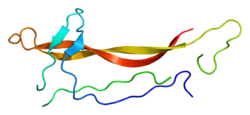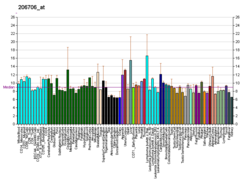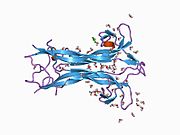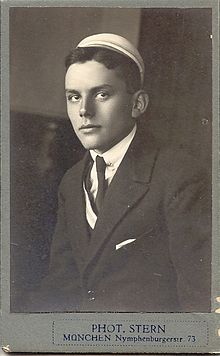뉴로트로핀-3
Neurotrophin-3| NTF3 | |||||||||||||||||||||||||||||||||||||||||||||||||||
|---|---|---|---|---|---|---|---|---|---|---|---|---|---|---|---|---|---|---|---|---|---|---|---|---|---|---|---|---|---|---|---|---|---|---|---|---|---|---|---|---|---|---|---|---|---|---|---|---|---|---|---|
 | |||||||||||||||||||||||||||||||||||||||||||||||||||
| |||||||||||||||||||||||||||||||||||||||||||||||||||
| 식별자 | |||||||||||||||||||||||||||||||||||||||||||||||||||
| 에일리어스 | NTF3, HDNF, NGF-2, NGF2, NT-3, NT3, 뉴로트로핀3 | ||||||||||||||||||||||||||||||||||||||||||||||||||
| 외부 ID | OMIM: 162660 MGI: 97380 HomoloGene: 1896 GeneCard: NTF3 | ||||||||||||||||||||||||||||||||||||||||||||||||||
| |||||||||||||||||||||||||||||||||||||||||||||||||||
| |||||||||||||||||||||||||||||||||||||||||||||||||||
| |||||||||||||||||||||||||||||||||||||||||||||||||||
| |||||||||||||||||||||||||||||||||||||||||||||||||||
| 위키데이터 | |||||||||||||||||||||||||||||||||||||||||||||||||||
| |||||||||||||||||||||||||||||||||||||||||||||||||||
뉴로트로핀-3는 NTF3 [5][6]유전자에 의해 인간에서 암호화되는 단백질이다.
이 유전자에 의해 코드된 단백질 NT-3는 신경로핀의 NGF(Nerve Growth Factor) 계열의 신경영양인자이다.말초와 중추신경계의 특정 뉴런에 활성을 갖는 단백질 성장인자로 기존 뉴런의 생존과 분화를 지원하고 새로운 뉴런과 시냅스의 성장과 분화를 촉진합니다.NT-3는 신경성장인자(NGF)와 BDNF(Brain Derived Neurotive [7]Factor)에 이어 세 번째로 특징지어지는 신경영양인자였다.
기능.
포유류의 뇌에 있는 대부분의 뉴런은 사후에 형성되지만, 성체 뇌의 일부분은 신경줄기세포로부터 새로운 뉴런을 자라게 하는 능력, 즉 신경생성이라고 알려진 과정을 가지고 있다.뉴로트로핀은 신경 생성을 자극하고 조절하는 데 도움을 주는 화학 물질이다.
NT-3는 두 개의 수용체 티로신 키나제 신경트로핀 수용체를 활성화하는 능력을 고려할 때 잠재적으로 자극할 수 있는 뉴런의 수에서 독특하다(TrkC 및 TrkB – 아래 참조).
NT-3를 만드는 능력 없이 태어난 쥐들은 고유 수용성 및 기계적 수용성 감각 [8][9]뉴런의 하위 세트를 잃었습니다.
작용 메커니즘
NT-3는 이 성장 인자에 반응할 수 있는 세포 표면에 세 개의 수용체를 결합시킨다.
- TrkC(Track C로 발음)는 NT-3에 가장 [10][11]큰 친화력으로 결합한다는 점에서 분명히 "생리학적인" 수용체이다.
- 그러나 NT-3는 TrkB라고 불리는 TrkC 관련 수용체를 통해 결합 및 시그널링이 가능하다.
- 마지막으로 NT-3는 LNGFR(저친화성 신경 성장인자 수용체)라고 불리는 Trk 수용체 외에 2차 수용체 유형도 결합한다.
고친화성 수용체
TrkC는 수용체 티로신 키나제이다(세포 내 특정 티로신에 인산염 분자를 첨가하여 세포 신호를 활성화시킴으로써 작용을 매개한다는 의미).
상기한 바와 같이 Trk 수용체로는 TrkA와 TrkB가 있다.또한 전술한 바와 같이 NT-3와 구조적으로 관련된 다른 신경영양인자가 있다.
TrkB는 BDNF, NT-4 및 NT-3의 영향을 매개하는 반면 TrkA는 NGF에 의해 바인딩되어 활성화되며 TrkC는 NT-3에만 의해 바인딩되어 활성화됩니다.
저친화성 수용체
다른 NT-3 수용체인 LNGFR은 다소 덜 명확한 역할을 한다.일부 연구자들은 LNGFR이 결합하고 신경로핀의 "싱크" 역할을 한다는 것을 보여 주었다.
NT-3의 결정 구조는 NT-3가 두 개의 글리코실화 p75 LNGFR 분자가 대칭적으로 결합하는 중심 호모디머를 형성한다는 것을 보여준다.대칭 바인딩은 NT-3 인터페이스를 따라 이루어지며 중앙에 [12]2:2 리간드 리셉터 클러스터가 생성됩니다.
따라서 LNGFR 수용체와 Trk 수용체를 모두 발현하는 세포는 신경트로핀의 "마이크로 농도"가 더 높기 때문에 더 큰 활성을 가질 수 있다.
그러나 LNGFR은 세포자멸을 통해 세포사멸 신호를 보낼 수 있으므로 Trk 수용체가 없는 상태에서 LNGFR을 발현하는 세포는 신경트로핀이 있는 상태에서 살기보다는 죽을 수 있다.
「 」를 참조해 주세요.
레퍼런스
- ^ a b c GRCh38: 앙상블 릴리즈 89: ENSG00000185652 - 앙상블, 2017년 5월
- ^ a b c GRCm38: 앙상블 릴리즈 89: ENSMUSG000049107 - 앙상블, 2017년 5월
- ^ "Human PubMed Reference:". National Center for Biotechnology Information, U.S. National Library of Medicine.
- ^ "Mouse PubMed Reference:". National Center for Biotechnology Information, U.S. National Library of Medicine.
- ^ Maisonpierre PC, Le Beau MM, Espinosa R III, Ip NY, Belluscio L, de la Monte SM, Squinto S, Furth ME, Yancopoulos GD (Oct 1991). "Human and rat brain-derived neurotrophic factor and neurotrophin-3: gene structures, distributions, and chromosomal localizations". Genomics. 10 (3): 558–68. doi:10.1016/0888-7543(91)90436-I. PMID 1889806.
- ^ "Entrez Gene: NTF3 neurotrophin 3".
- ^ Maisonpierre P, Belluscio L, Squinto S, Ip N, Furth M, Lindsay R, Yancopoulos G (1990). "Neurotrophin-3: a neurotrophic factor related to NGF and BDNF". Science. 247 (4949 Pt 1): 1446–51. Bibcode:1990Sci...247.1446M. doi:10.1126/science.2321006. PMID 2321006.
- ^ Tessarollo L, Vogel K, Palko M, Reid S, Parada L (1994). "Targeted mutation in the neurotrophin-3 gene results in loss of muscle sensory neurons". Proc Natl Acad Sci USA. 91 (25): 11844–8. Bibcode:1994PNAS...9111844T. doi:10.1073/pnas.91.25.11844. PMC 45332. PMID 7991545.
- ^ Klein R, Silos-Santiago I, Smeyne R, Lira S, Brambilla R, Bryant S, Zhang L, Snider W, Barbacid M (1994). "Disruption of the neurotrophin-3 receptor gene trkC eliminates la muscle afferents and results in abnormal movements". Nature. 368 (6468): 249–51. Bibcode:1994Natur.368..249K. doi:10.1038/368249a0. PMID 8145824. S2CID 4328770.
- ^ Lamballe F, Klein R, Barbacid M (1991). "trkC, a new member of the trk family of tyrosine protein kinases, is a receptor for neurotrophin-3". Cell. 66 (5): 967–79. doi:10.1016/0092-8674(91)90442-2. PMID 1653651. S2CID 23448391.
- ^ Tessarollo L, Tsoulfas P, Martin-Zanca D, Gilbert D, Jenkins N, Copeland N, Parada L (1993). "trkC, a receptor for neurotrophin-3, is widely expressed in the developing nervous system and in non-neuronal tissues". Development. 118 (2): 463–75. doi:10.1242/dev.118.2.463. PMID 8223273.
- ^ Gong Y, Cao P, Yu HJ, Jiang T (August 2008). "Crystal structure of the neurotrophin-3 and p75NTR symmetrical complex". Nature. 454 (7205): 789–93. Bibcode:2008Natur.454..789G. doi:10.1038/nature07089. PMID 18596692. S2CID 4333271.
추가 정보
- Kalcheim C, Carmeli C, Rosenthal A (1992). "Neurotrophin 3 is a mitogen for cultured neural crest cells". Proc. Natl. Acad. Sci. U.S.A. 89 (5): 1661–5. Bibcode:1992PNAS...89.1661K. doi:10.1073/pnas.89.5.1661. PMC 48512. PMID 1542658.
- Ozçelik T, Rosenthal A, Francke U (1991). "Chromosomal mapping of brain-derived neurotrophic factor and neurotrophin-3 genes in man and mouse". Genomics. 10 (3): 569–75. doi:10.1016/0888-7543(91)90437-J. PMID 1889807.
- Hallböök F, Ibáñez CF, Persson H (1991). "Evolutionary studies of the nerve growth factor family reveal a novel member abundantly expressed in Xenopus ovary". Neuron. 6 (5): 845–58. doi:10.1016/0896-6273(91)90180-8. PMID 2025430. S2CID 17772282.
- Jones KR, Reichardt LF (1990). "Molecular cloning of a human gene that is a member of the nerve growth factor family". Proc. Natl. Acad. Sci. U.S.A. 87 (20): 8060–4. Bibcode:1990PNAS...87.8060J. doi:10.1073/pnas.87.20.8060. PMC 54892. PMID 2236018.
- Rosenthal A, Goeddel DV, Nguyen T, et al. (1990). "Primary structure and biological activity of a novel human neurotrophic factor". Neuron. 4 (5): 767–73. doi:10.1016/0896-6273(90)90203-R. PMID 2344409. S2CID 30148948.
- Kaisho Y, Yoshimura K, Nakahama K (1990). "Cloning and expression of a cDNA encoding a novel human neurotrophic factor". FEBS Lett. 266 (1–2): 187–91. doi:10.1016/0014-5793(90)81536-W. PMID 2365067. S2CID 7645464.
- Ernfors P, Lee KF, Kucera J, Jaenisch R (1994). "Lack of neurotrophin-3 leads to deficiencies in the peripheral nervous system and loss of limb proprioceptive afferents". Cell. 77 (4): 503–12. doi:10.1016/0092-8674(94)90213-5. PMID 7514502. S2CID 9072110.
- Robinson RC, Radziejewski C, Stuart DI, Jones EY (1995). "Structure of the brain-derived neurotrophic factor/neurotrophin 3 heterodimer". Biochemistry. 34 (13): 4139–46. doi:10.1021/bi00013a001. PMID 7703225.
- Hattori M, Nanko S (1995). "Association of neurotrophin-3 gene variant with severe forms of schizophrenia". Biochem. Biophys. Res. Commun. 209 (2): 513–8. doi:10.1006/bbrc.1995.1531. PMID 7733919.
- Tessarollo L, Vogel KS, Palko ME, et al. (1995). "Targeted mutation in the neurotrophin-3 gene results in loss of muscle sensory neurons". Proc. Natl. Acad. Sci. U.S.A. 91 (25): 11844–8. doi:10.1073/pnas.91.25.11844. PMC 45332. PMID 7991545.
- Rydén M, Ibáñez CF (1996). "Binding of neurotrophin-3 to p75LNGFR, TrkA, and TrkB mediated by a single functional epitope distinct from that recognized by trkC". J. Biol. Chem. 271 (10): 5623–7. doi:10.1074/jbc.271.10.5623. PMID 8621424.
- Hui JO, Le J, Katta V, et al. (1996). "Human neurotrophin-3: a one-step peptide mapping method and complete disulfide characterization of the recombinant protein". J. Protein Chem. 15 (4): 351–8. doi:10.1007/BF01886861. PMID 8819011. S2CID 34957071.
- Donovan MJ, Hahn R, Tessarollo L, Hempstead BL (1996). "Identification of an essential nonneuronal function of neurotrophin 3 in mammalian cardiac development". Nat. Genet. 14 (2): 210–3. doi:10.1038/ng1096-210. PMID 8841198. S2CID 9259115.
- Arinami T, Takekoshi K, Itokawa M, et al. (1996). "Failure to find associations of the CA repeat polymorphism in the first intron and the Gly-63/Glu-63 polymorphism of the neurotrophin-3 gene with schizophrenia". Psychiatr. Genet. 6 (1): 13–5. doi:10.1097/00041444-199621000-00003. PMID 8925252. S2CID 42610869.
- Urfer R, Tsoulfas P, O'Connell L, et al. (1998). "High resolution mapping of the binding site of TrkA for nerve growth factor and TrkC for neurotrophin-3 on the second immunoglobulin-like domain of the Trk receptors". J. Biol. Chem. 273 (10): 5829–40. doi:10.1074/jbc.273.10.5829. PMID 9488719.
- Suenaga M, Ohmae H, Tsuji S, et al. (1998). "Renaturation of recombinant human neurotrophin-3 from inclusion bodies using a suppressor agent of aggregation". Biotechnol. Appl. Biochem. 28 (2): 119–24. PMID 9756741.
- Hochhaus F, Koehne P, Schäper C, et al. (2003). "Elevated nerve growth factor and neurotrophin-3 levels in cerebrospinal fluid of children with hydrocephalus". BMC Pediatrics. 1: 2. doi:10.1186/1471-2431-1-2. PMC 57003. PMID 11580868.
- Kobayashi H, Gleich GJ, Butterfield JH, Kita H (2002). "Human eosinophils produce neurotrophins and secrete nerve growth factor on immunologic stimuli". Blood. 99 (6): 2214–20. doi:10.1182/blood.V99.6.2214. PMID 11877300.
- Hattori M, Kunugi H, Akahane A, et al. (2002). "Novel polymorphisms in the promoter region of the neurotrophin-3 gene and their associations with schizophrenia". Am. J. Med. Genet. 114 (3): 304–9. doi:10.1002/ajmg.10248. PMID 11920853.










